Hypebeast vs. Highsnobiety: A Journey Toward the Heart of Content
|Thom Bettridge
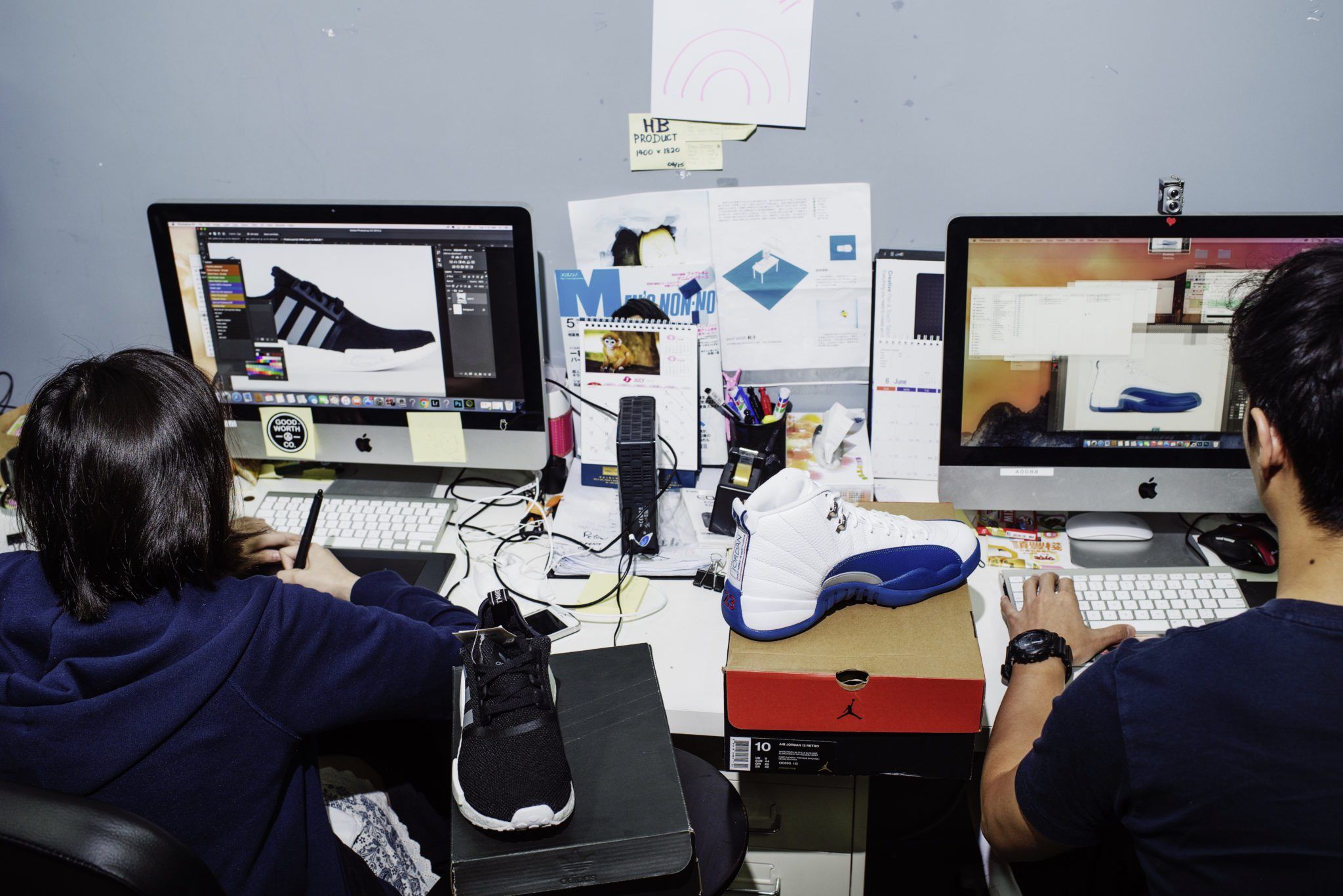
Founded in 2005 by sneaker enthusiast and college student Kevin Ma, Hypebeast is a footwear blog that has grown into a loud and unignorable voice in culture media at large. While older and more established publications struggle to navigate online distribution and payment models, Hypebeast has operated as a lean and efficient content machine built for the pace of today’s feeds. Realizing his site’s magnetism among young super-consumers, Ma has diversified Hypebeast into an e-commerce platform and a destination for native advertising. This year, the site became the first sneaker blog to be listed as a publically traded company.
Another major site in this sector pioneered by Ma is Highsnobiety, which shares an almost identical paradigm and origin story. Founded in 2005 by Swiss business-student-turned-blogger David Fischer, Highsnobiety has since doubled down on the revenue model of sponsored content, working with clients in a lifestyle industry rabidly hunting to find its voice online. In a prismatic landscape filled with social media platforms and “shareable” products, Fischer vies to maintain the trust of his followers and Highsnobiety’s established place on the feed.
As Hypebeast and Highsnobiety grow, the world around them seems to be following suit. The product calendar has begun to approximate the dizzying pace of their web posts, and brands are feeling the need to trade in content as opposed to advertising. But even in an industry that recognizes content’s power, the question of what content actually is remains an enigma.
Thom Bettridge visited Hypebeast and Highsnobiety’s headquarters to take a closer look at the anatomy of fashion’s two leading content machines.

10:13 – Hypebeast HQ, Hong Kong
Across the harbor from Hong Kong Central, past the shopping centers in Tsim Sha Tsui and through the electronics markets in Mong Kok, farther north and near the container terminals in Kwai Tsing: This is where you find The Heart of Content.
12 stories up from an industrial loading dock, Hypebeast’s headquarters looks like a SoHo loft space teleported to the fringes of Hong Kong. I arrive covered in sweat from the humidity outside and am immediately greeted with a tour of the newsroom: the print magazine desk, the China desk, the Japan desk, the in-house photo studio, the graphic design desk. An editor in a fitted cap shows me a website dedicated to Champion basketball jerseys (the ones from the 1990s), another shows me a travel carry-on that unfolds into a scooter. I watch as the others make content: Legions of sub-editors plugging 150-word blog posts into WordPress. The ambiance feels like the ground floor of a stock exchange, but with an attitude softened by Adidas Boost cushioning and the attentive silence of web surfing. It is a modestly sized office for a company that has irrevocably disrupted fashion media, commanding an unprecedented number of followers across more than half a dozen online platforms. I stand in the middle of it all, imagining hypebeast.com’s millions of unique monthly visitors filling up the room like a flood of graphic t-shirts. I need a glass of water.
In the corner of the loft, Hypebeast founder and CEO Kevin Ma paces inside his glass cube, conducting a conference call. He hangs up the phone, and an administrator beckons me inside. Ma apologizes for the clutter, but the room is actually quite spare. Behind my chair sits an oval-shaped Dyson fan, a plastic tub of whey protein powder, and a folding bicycle. Ma is now at his desk, seated next to a tower of orange Nike shoe boxes that stack up his chin. Above him, a Mitsubishi console blows cool air onto his body as he sits erectly, with a fresh-faced and alert presence. The administrator brings us juice-boxes filled with lemon flavored iced tea, and I ask Ma how this whole endeavor began.
THOM BETTRIDGE: Tell me about the beginning of Hypebeast. What did you see in the world that made you want to start the site?
KEVIN MA: It was quite an organic approach. I didn’t really think about starting a company in the beginning. I didn’t even study fashion or anything like that, so it was just a coincidence that somehow along the way I was going online to browse different fashion websites at that time. There weren’t that many. I was heavily into sneakers as well, so I would be on sneaker forums like Nike Talk and things like that. I was almost like a fan who followed this culture. And I guess at some point, I was looking at these different sources for my information – getting this info from all these sources and buying stuff I liked – and I figured, “Why not document all of it?” So I went to blogger.com and registered hypebeast.blogspot.com.
What else were you doing at this point in your life?
I was almost finishing university. I majored in economics and psychology – so, totally irrelevant. But I always liked the business aspects of things and at the same time was really into fashion. Then after I graduated, I went to a full-time job at a financial institution, because of my economics background. I did that for six months and along the way I was basically running Hypebeast after work. I’d go to work early morning, get off work, rush home, and update the website. Because I really loved what I was doing. I would blog until the middle of the night, then go to sleep, and repeat.
So you weren’t seeing a lot of people at the time.
Yeah, other than grabbing quick dinner. I would go to work, go home, and that was my life for some time. It was a grind, but after a few months, I remember looking at the viewer tracker and I was like, “Oh wow, we almost have 10,000 readers.” And it was pretty cool to know that 10,000 people are looking at what I’m writing about. We used this program called AdSense. And as a kid, you want ads to pay your own server fees so you don’t go out of pocket. I mean, they weren’t the most beautiful ads in the world, but it kept the server going and allowed me to feed my addiction. I could buy more sneakers.
Why the name Hypebeast?
I didn’t make it up to be honest. It was a term used on a lot of these sneaker forums. Basically what it meant was almost a negative connotation. It meant that you were buying without thinking about what you were actually buying. You’re just following the hype.
It’s funny that you named this passion project after something with a negative connotation.
I didn’t really think about it. It was very organic.

The Golden Rule
In a mall near the headquarters, I eat lunch at an Italian restaurant with Hypebeast’s three-headed hydra of senior editors, Petar Kujundzic, Arthur Bray, and Arby Li, who manage Hypebeast’s daily output from a cramped standing-desk towards the front of the office. They sit with their phones out on the table, periodically waving their fingers through small hurricanes of push notifications. When I ask them about the secrets of their occupation, they explain to me The Golden Rule: “Always post about news and innovations, and post it fast.”
Speed and newness are central to the Hypebeast methodology. Each of its sub-editors are tasked with creating nearly a dozen articles during each work day, sometimes up to 20. This super-human output is made possible by a craft called “re-posting,” a process that begins with the editorial team’s massive intake system of RSS feeds, press releases, browser bookmarks, and media kits from advertising partners. Favorites from this pool are then finessed, copy-pasted, and paraphrased into short web articles in the company’s house style – informational hors d’oeuvres featuring a paragraph of text, an image, and a hyperlink. The senior editors across each major city – Hong Kong, Tokyo, New York City – then preside over this swell of material, curating the mix of publishing throughout the day and handing off posts to Hypebeast’s social media coordinators, who blast the stories onto every possible platform. This is the recipe for “content.” Or maybe, it is just a minimalist study on how little a document needs in order to be considered an article. Either way, the result is a gargantuan game of show-and-tell that occurs across all timezones at an unreal rate – This motorcycle, These Timberlands, This hoodie.
While Hypebeast’s output has grown to include features, editor’s picks, and other types of more in-depth productions, the re-post (which lies somewhere between journalism and a social media share) remains the cornerstone of its editorial agenda. It is an art form that was perfected with the dawn of blogging, the short-lived media revolution from the mid-2000s that allowed anyone with a digital camera to become a food/art/music/film critic. Hypebeast was born from this rise of populist connoisseurship, and Ma himself – a sneaker collector turned media don – is a champion of its amateur zeitgeist. Yet, while blogging’s moment in the sun was quickly foreclosed by the even greater accessibility of mobile-based social media, Hypebeast appears to be a mutant species that grows stronger with every new platform that joins the ecosystem. Its editors tell me they are unphased by the potential of “cannibalizing” their own content by posting it in so many places at such a high frequency. Each item pushed down in the feed is replaced by something newer and equally delectable. As the editors and I discuss the inner-workings of this machine, Kujundzic leaks another powerful and telling mantra: “Never look back.”
At the time you started Hypebeast, you were looking at a lot of other sneaker sites and forums. Why do you think your site was the one that grew bigger than all the others?
KEVIN MA: There were other websites doing this kind of stuff before us. But I think the thing with those websites is that they were not updated enough. They would update like once a week – or once every so often – because it was hard to update html websites. You had to know how to code a little bit and then upload to your FTP-server and change the website. It was very web 1.0. When we came in, blogging was starting to take off. There were platforms like Blogger that enabled people to express whatever they liked much more easily. It was much easier to share information. You just click a button, publish, and done.
So you were the fastest.
Well, that platform enabled us to update easily. Those original websites didn’t update enough. Maybe they had other stuff to do, but I was a college kid with nothing much to do other than go to work in the morning and get off work and update the site. With sneaker forums, you have to be a hardcore fan. You have to spend a lot of time on sneaker forums to read that information, because there’s a lot of different threads and subjects you have to dig through. But I was a fan, so I would dig through that kind of stuff all day long. So, I think the website just made it easy for more people to be able to enjoy the same information.
You always hear about how more traditional, journalistic institutions are having trouble in the digital era. Many are so fragile that even a new ad blocker or a slight change in the Facebook algorithm puts them in existential danger. But given the amount of content you can create by re-posting, it makes sense why these news organizations with monster writing staffs are having trouble keeping up.
It’s just different. It’s a different platform. It’s like television versus YouTube. On TV, there’s a certain standard they have to abide by, but on YouTube you can take a video of yourself and that’s content as well. It’s not to say which one is the right way or the wrong way, but it just happens to be the way of the Internet.
It’s interesting, because you talked about how blogging created a new type of producer – a hobbyist producer – as opposed to someone who knows how to use html. Now with social media, you don’t even have to be a hobbyist. Anyone can curate and share content. Did Instagram disrupt your business?
We always try to keep the mindset of trying to embrace new stuff. Because you don’t know what’s going to be the next big thing. Blogspot was the big thing when we started, so we always try to keep an open mind. So when Instagram came, we were like, “Let’s get on and share our photos!”
Same with Snapchat now.
All the social media platforms. It’s a lot of work to be honest.
Because new ones come, but you still have to do the old ones as well.
You can’t not do them. But it’s worth it. You have to look at where people’s habits are, and instead of fighting it, try to embrace it.
A.D.I.D.A.S. (All Day I Dream About Swag)
Near the bathroom in the Hypebeast headquarters, I discover an A4 poster done in the style of Kanye West’s Life of Pablo album cover. It has an orange background and columns of text reading “SWAG PILE FRIDAY” copy-pasted over and over again in Helvetica Black. I ask one of the editors about the event, and he explains that on certain Fridays the Hypebeast staff convenes around a conference table to divvy up merchandise gifted to the company by various brands. A hoard of influencers feasting on gadgets, skincare products, and athleisure, all huddled around the ceremonial swag pile – this is how Hieronymous Bosch would paint today’s publishing landscape. The image also reveals the appetite that serves as fuel for Hypebeast’s media machine. If content is this machine’s output, then raw consumer lust – the hunger of the beast – is its input. These two components are encoded in the site’s name, yet the boundaries between them – as with any desire-machine – are the opposite of cut-and-dry.
“Swag” itself is a tricky word that carries with it a prismatic set of meanings. In media circles, swag is an acronym for Stuff We All Get, a reference to the free merch that brands give out to the press and other potential benefactors. In pop culture, swag is a slang morpheme of “swagger,” a way of saying that something is cool that reached its height of visibility through Supreme ambassador and Hypebeast icon Tyler the Creator. But what happens when you get your swags crossed? When SWAG is also swag? As I chewed over this dilemma weeks later, I emailed the senior editors in Hong Kong to ask them what they think the word means. They answered me succinctly and in unison: “Swag is a sign of approval.”
As a product and story aggregator, Hypebeast is in the business of giving signs of approval. It provides this service mainly to hyper-consumers in the male 18-35 demographic, those who follow the latest developments in sneakers and streetwear with the intent of being the first to buy new products. It also provides it to advertisers, who are gravitationally drawn to the site’s hold on this group’s flighty purchasing habits. After beginning with a classic ad revenue model, Ma has since diversified the Hypebeast business into an e-commerce platform called HBX and a repertoire of content partnerships with brands. From an orthodox perspective that views sponsored content as anathema and sees publications that sell products as catalogs, this could be seen as a major breach in editorial purity. But in the case of Hypebeast, it is questionable whether such an outlook even applies to what we call “content.” From its bedroom days, Ma’s site has been a devotional platform dedicated to footwear brands and their ever-mutating product lines. This is a reality that makes Hypebeast’s new revenue models look more like vertical integration than selling out. In an editorially pure vacuum, the site was already a compendium of free advertising. Aside from small “sponsored” tags, Hypebeast’s native advertising today is so “native” that it is nearly impossible to distinguish what it does for hire from what it does on its own volition. A love of product is the podium on which the site speaks. This is content’s original sin. Across the board, the message is unified: Here is the Stuff We All Get, and we think it is as swag as you do.

When you began doing sponsored content, were you worried about violating the loyalty of your fans?
KEVIN MA: That’s a tough one to be honest. And we’ve been battling internally a lot. Because Hypebeast is not a hobby anymore. It’s still a passion, but it’s a business as well. The whole industry is moving toward that direction, so I think as long as you’re transparent and you’re doing stuff with brands that you enjoy, you need to do it.
Has working on sponsored content always felt natural? Or is it a process of trial and error?
I’m sure there have been moments where we were testing it out. We try to control it as best as possible, but we’re working with the needs of different customers and clients as well. I guess our job is to ensure that we do the best we can and help the client out. They’re here to get helped out, right?
And you have such an active comments section. Whenever you do something your audience isn’t into, the trolls will immediately rip it apart.
Yeah, and we love it to be honest. We love our commenters. Without them, we wouldn’t be the Hypebeast of today. Sometimes when they call us out, it’s definitely needed. But we obviously don’t take every comment into consideration. It gets pretty crazy in there.
Lots of people barking at each other.
There’s a lot of debates.
“Debates.” That’s a good way to put it.
It’s funny.
The Coronation of the Sneakerhead
From its beginning in 2005, Ma recognized that the power of Hypebeast rested in its ability to translate the ornate, obsessive, and troll-laden world of sneaker forums into material that could be consumed by the general public. At this time, a new wave of “energy marketing” saw footwear brands expanding the scope of their products into a vast repertoire of retro re-releases, artist collaborations, and indie label exclusives. It was a formative period for the This x That logic of brand synergy, one that saw athleticwear multinationals directly trading on the rarified air of graffiti, high fashion, skateboarding, and vintage basketball. It was the moment when mainstream fashion began to also deal in content.
During these origin years, Hypebeast was a useful news source for tracking the sporadic and somewhat secretive “drops” that released these cross-pollinated artifacts. But now that this practice of cultural collision has expanded from sneakers outward, it feels impossible to ignore Ma’s role in how consumerism has been re-sculpted into a garden of corporatized subcultures. Meanwhile, the site’s archetypal user has become the supreme ideal of the contemporary purchaser. This garden is the den of the Hypebeast. And as its editors explain to me: “Our culture is built upon niche energy.”
Ma himself credits sneaker collaborations with personally educating him on contemporary art and high fashion. And as his site’s coverage expands with his own interests, it is apparent that Hypebeast still views all cultural material through the lens of a sneaker. This point of contact – between product and content – creates a bandwidth wherein Hypebeast can speak freely about Drake, Yohji Yamamoto, and Barbara Kruger within the exact same lexicon. Their language of hype embraces convergence wholeheartedly, to the extent that these collisions are no longer as shocking as they once were in a different time. Everything is a collab. Everyone is dropping something. And everything is for sale.
Hypebeast started as a word on sneaker forums. Then it became your site. And now a “hypebeast” is a type of person. How would you describe this person?
KEVIN MA: I think it’s multiple people at once. We’ve never really come out and said, “Oh, this is the hypebeast person.” The Hypebeast name is just a label for people who like this kind of stuff. Trends change. And over time, it’s not something we dictate. You can say that the readers dictate it themselves.
Because you’re aggregating most of the content.
We’re just documenting what’s going on in this culture.
At first, the site was dedicated to sneaker culture, but now it has grown to address so many different worlds. Has that progression felt natural to you?
Sneakers were the starting point, because I was very interested in sneakers – nice colors, different variations, limited editions. As a younger person, you want to own something you appreciate. You can’t own cars because you can’t afford them. You can’t own lofts, or watches, or things like that. So the closest thing you could own was sneakers. Also, with sneakers there was a community of like-minded people. That’s why we started out with sneakers. But at the time, there were a lot of different collaborations – so you would learn about brands, musicians, and graffiti artists from these different collaborations. I didn’t come from art – I didn’t paint trains – but I learned about art through sneakers. At that time, Japanese streetwear was also booming and that was connected to sneakers as well. So it was more like a learning process – learning about street fashion and street art, to then learning about high fashion and high art. It was like a tree branching into different areas.
Do you still collect sneakers?
Not so much any more. I’m more utilitarian. I buy something because I want to wear it. I think Hypebeast destroyed my passion for collecting – no, just kidding. I think I’m just more interested in observing as opposed to actually owning things now.
But you were once really into collecting sneakers.
Of course, like: “Wow! I got to buy this.” Especially if I had to hunt for it – like if I had to travel to Tokyo to find it, or go on eBay to bid for it.
What was the most amazing sneaker you ever bought?
I don’t really go for the high profile kind of stuff. It’s more about emotional bonding with the stuff I buy. I think more about the time I bought a pair of sneakers – about how I lined up overnight and met a bunch of people through the line-up.
Do you have a particular experience like that? A pair with a strong memory?
Of course. I remember one time Alife was launching a pair of collaborations in Vancouver. I think it was the Puma with tennis ball material. And it wasn’t like the hottest ones I ever saw, but I remember during that line-up there were some strangers in front of me talking about how they saw this and that on Hypebeast. And I thought that was really cool. Meeting people in real life who were reading the site.
The Hypebeast founding concept is built around sharing rarified information that you originally found on obscure forums. But doesn’t this information lose its weight once you share it?
I think there is some pushback from the so-called “OG guys” about this. And sometimes you want to keep a secret because you don’t want your spot to be ruined. But it’s almost inevitable that it will happen at some point. If we’re not doing it, someone else is going to. I do sometimes miss the old times, when this was a small community, but sharing is cool. What if I lived in the middle of nowhere – not in Paris, not in Tokyo, not in New York – how would I ever learn about this cool stuff? The only access I would have is the Internet.
What’s your core demographic in terms of age and sex?
I guess from stats it’s 18-to-35-year-olds. It’s interesting to see this demographic, because it has actually widened in terms of the age range. In the beginning, it was high school and college folks, but then I think they grew up and they’re still checking it. It’s interesting because we would have guessed that once you graduate that age, you’d be into suits or something like that. But people are staying young longer. A lot of girls are interested in our content as well.
And that’s why you opened up Hypebae. How did that discussion start?
It was kind of an internal joke at first. We wanted to have a feature with different models, who we would call “hypebaes.”
Does the hypebae mate with the hypebeast?
No, not that! But I guess it’s the female version of the hypebeast. We also had this April Fools joke where we had this app called “Hypebae” – which is like Tinder, but for meeting your hypebeast or bae. So at first it was a joke, but then at some point, we realized that there were actually a lot of girls on our site who were looking for this kind of content. So we began asking ourselves how to create something for our female audience.
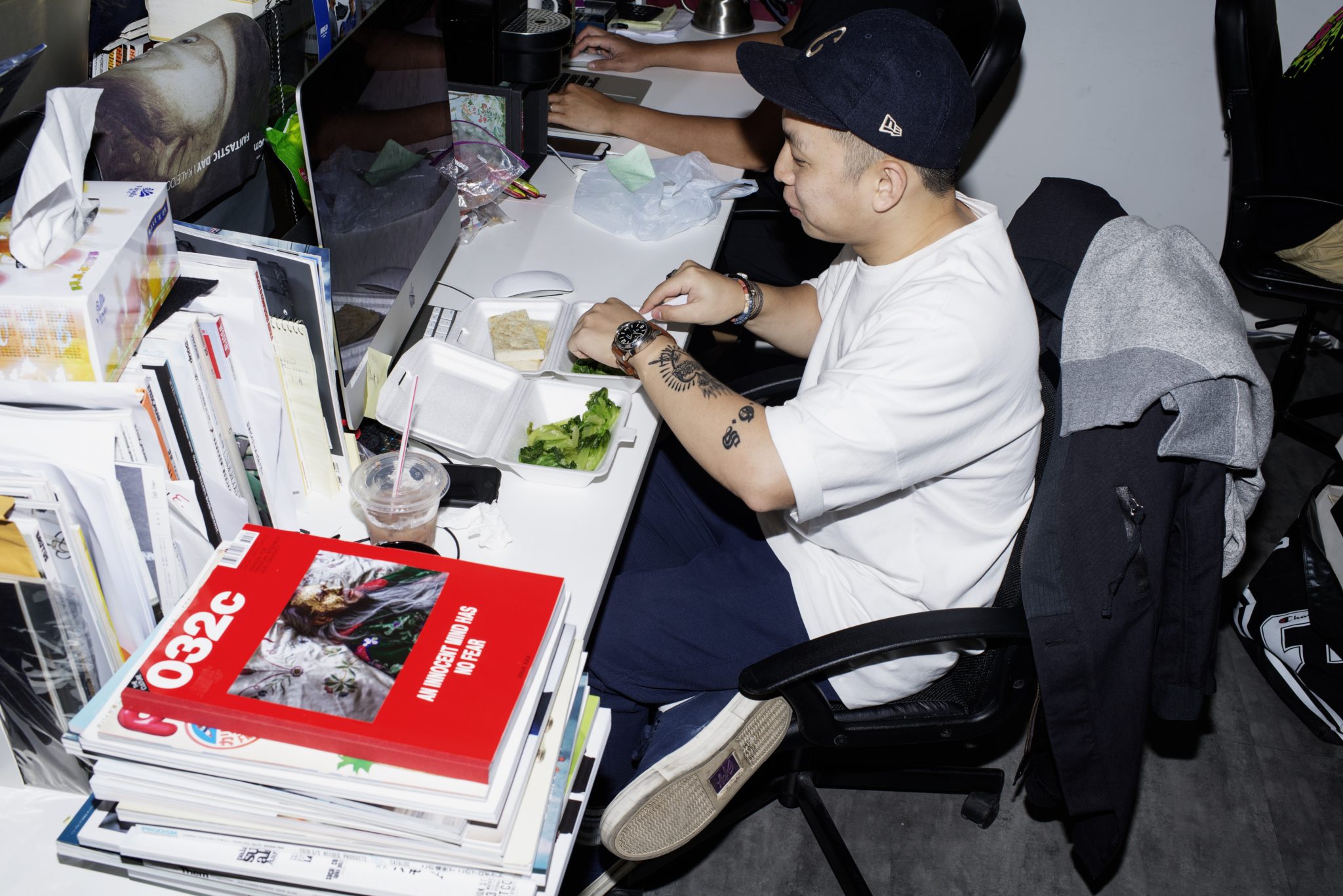
The Cycle
If Hypebeast is in the business of mining niche energy, then their economic model begs the question of whether this commodity has a finite supply. Newness and rarity are, by virtue of themselves, self-expiring values. Something is rare until it is shared, new until it is bought. Mix that with the hunger of the Beast – or Bae – and you have a circumstance that resembles one of the ancient philosopher Zeno’s paradoxes. In the paradox of “Achilles and the Tortoise,” the Greek hero chases the slower tortoise in a race but never catches it. When Achilles reaches where the tortoise once was, the animal has already moved slightly forward, leaving him in a constant state of almost-arrival. The hypebeast finds himself in a similar position, perpetually on the cusp of trends that have been broken to a site with millions of followers, propelled forward by the chase of the next drop. Hypebeast’s job is to squeeze the Internet for all its niche as long as this appetite remains. And there has not yet been a sign of a saturation point.
Both news and trends are governed by cycles, and at this stage, Ma has chased more than a decade of circular motions. In this process, his tiny milieu has become the epicenter of commercial culture, and his pet project has become an international business. He has stopped collecting sneakers, yet he dutifully answers my questions next to his orange totem of Nike boxes, cloaked like a monk in a black outfit that matches his Primeknit Boosts. This year, Hypebeast has become the first sneaker blog to be listed as a publically traded company. But Ma reminds me that this progression was also organic.
You share the news cycle with many other sites on the Internet. How do you go about creating something that generates loyalty when you have competitors dropping the same news as you?
KEVIN MA: We focus on ourselves first and foremost, and what kind of unique content we can come up with that we and our audience appreciate. As long as we can do that, we’re satisfied with the results. But if one day we were creating content because the competitor is creating content, then we would lose the original focus of what we’re about. At the same time, for news coverage, time is obviously an important factor. The sooner you share big, breaking news, the better it is not only for your site, but also your readers. Our readers expect to be fully informed and entertained by the content we create. We don’t really think about other folks as competitors. The Internet is so big that everyone can survive.
What led you to base your company in Hong Kong?
No particular reason. I was born in Hong Kong, but then we immigrated to Vancouver when I was pretty young. Vancouver is a great, beautiful city, but when I was young, I wanted to have more of a night life. And Vancouver wasn’t that city. So I was like, “Hey, Hong Kong is where I was born, maybe I should go back and check it out.”
You’re also growing your business in the States, which is exactly 12 hours apart from here in terms of time zones. So now Hypebeast can deliver content all day. You own the entire clock.
Yes, I mean, while you’re resting, things are still happening. And you have to be quick when you’re talking about this stuff. Having that 24-hour shift – or whatever you call it – is quite useful.
Speed is an important part of Hypebeast. In the beginning, the efficiency of blogging is what helped you be so fast and consistent.
And we still think about how to increase efficiency. Nowadays, we analyze a lot of the data that comes in through Instagram, Facebook, Google Analytics. This allows you to make the user experience better by knowing things like the average size of people’s browsers. If you’re creating a website that is bigger than people’s browsers, they are not going to find it useable.
Are there any things you’ve learned from analytics that really surprised you?
It was surprising to find out how big our Japanese audience was. Now we have a Japanese site, but in the beginning we didn’t and we were like, “Wow, why is one of our top five countries Japan?” Another thing that surprised us is how quickly people started to visit on mobile.
Mobile is now about half of the readership on most sites, no?
I think more than half of our site’s traffic is probably from mobile now.
Speaking of rapid growth, Hypebeast recently became a publicly traded company. That’s a rare accomplishment for something that started as a blog.
It happened in April.
How did the decision to do that come about?
We wanted to continue growing our business – in terms of both media and e-commerce – and we wanted to raise funding to do what we want to do on a bigger scale. We thought about raising money privately, which is what most people do at first, but then we decided to do things differently.
So there hasn’t been venture capital money involved in Hypebeast, even earlier on?
No VCs, no investors. From day one, we would make money and put it back into the company. We obviously contemplated it, but with a VC you know the road, and it’s quite straightforward.
You aim for a big exit.
Yes, because they need to get the money back. But we don’t want to sell the company. It’s still super interesting to us, and we’re still very passionate about it. So I thought: “If the end goal is that exit for the VCs anyway, then why not just do a type of exit now? Why not just do an IPO now?” And through this, we were able to raise the money we needed to grow our business and we were able to do it on our own terms.
What are your future plans? Where do you see the company growing?
Four or five years ago, we launched an e-commerce platform. And it was one of those things, where as a young person, you dream about opening your own store and having your own brand. For us, it was pretty organic, because our audience would always ask where they could buy the stuff that they were seeing online every day. So when I look at how we want to expand, I think of these two core things: the media side and the e-commerce side.
As someone who has paid such close attention to sneakers and streetwear, where do you see this market as a whole growing?
To be honest, I don’t even know. It evolves and it changes every day. For example, I can’t really forecast what’s going to be cool next year. Especially now with social media, it’s even more democratic – anyone can have a voice to make stuff cool. The meaning of streetwear has also been different throughout my time. If ten years is a cycle, I’ve now seen one full cycle. When we first started, we were into sneakers, graphic tees, and things like that. Then, that trend in streetwear got overplayed, and it went to skinny jeans, Americana, more high fashion, plain stuff. And I guess that did pretty well for a while, but now it’s actually coming back into graphic tees and sneakers again. I haven’t been around long enough to see two cycles, but if I were to guess, it’s going to be another coming and going again. But every change is going to be a little different from the previous one. Not a lot of people are going to wear baggy jeans like back in the day, but it’s kind of an evolution out there like, “Hey, skinny jeans are quite … tight.” We’re moving forward in a circle.
12:00 – Highsnobiety HQ, Berlin
The room is small and bright. Its ceiling is a transparent, diagonal roof that spills sunlight onto the conference table where I share a bottle of Pellegrino with Highsnobiety founder David Fischer. Outside, in a much larger room, Fischer’s team is creating content. It is noon in Berlin, just three hours before the crucial moment in the daily schedule when the United States begins waking up and East Asia starts going to bed. The world is reading, liking, commenting, sharing. Yet the Highsnobiety office maintains a precise quiet. Perhaps it is the fact that they share their loft with a PR agency. Perhaps it is the subdued startup-chic of their office, an airy room with an iced coffee zen.
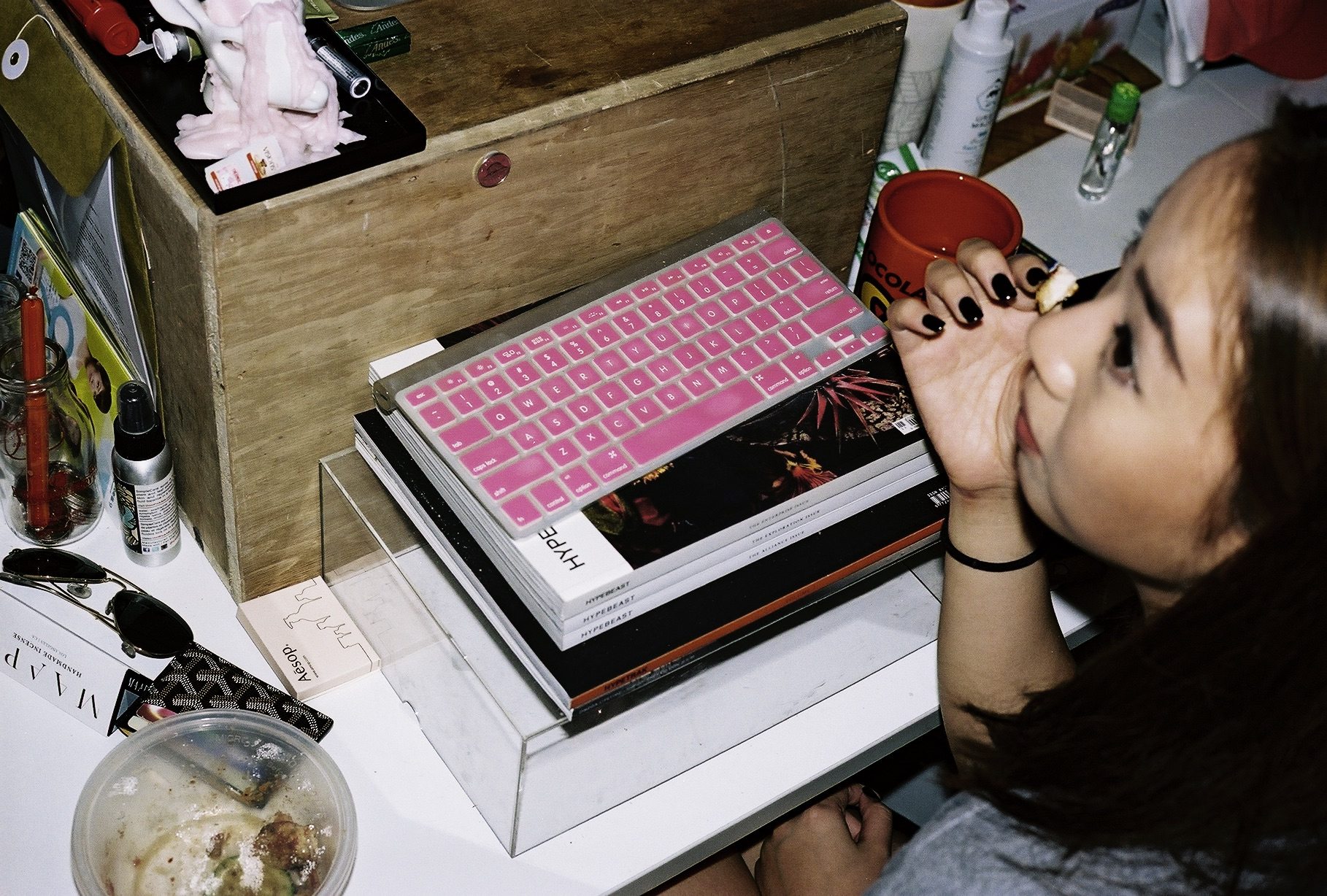
Fischer is wearing a graphic tee, thick-framed glasses, and a baseball cap. We are in this conference room together, because he does not have an office. Fischer is a spartan snob, and he prefers to sit in the trenches with his team. After starting Highsnobiety in 2005 as his lifestyle response to a tech blog, he has personally made sure that his website is never quiet.
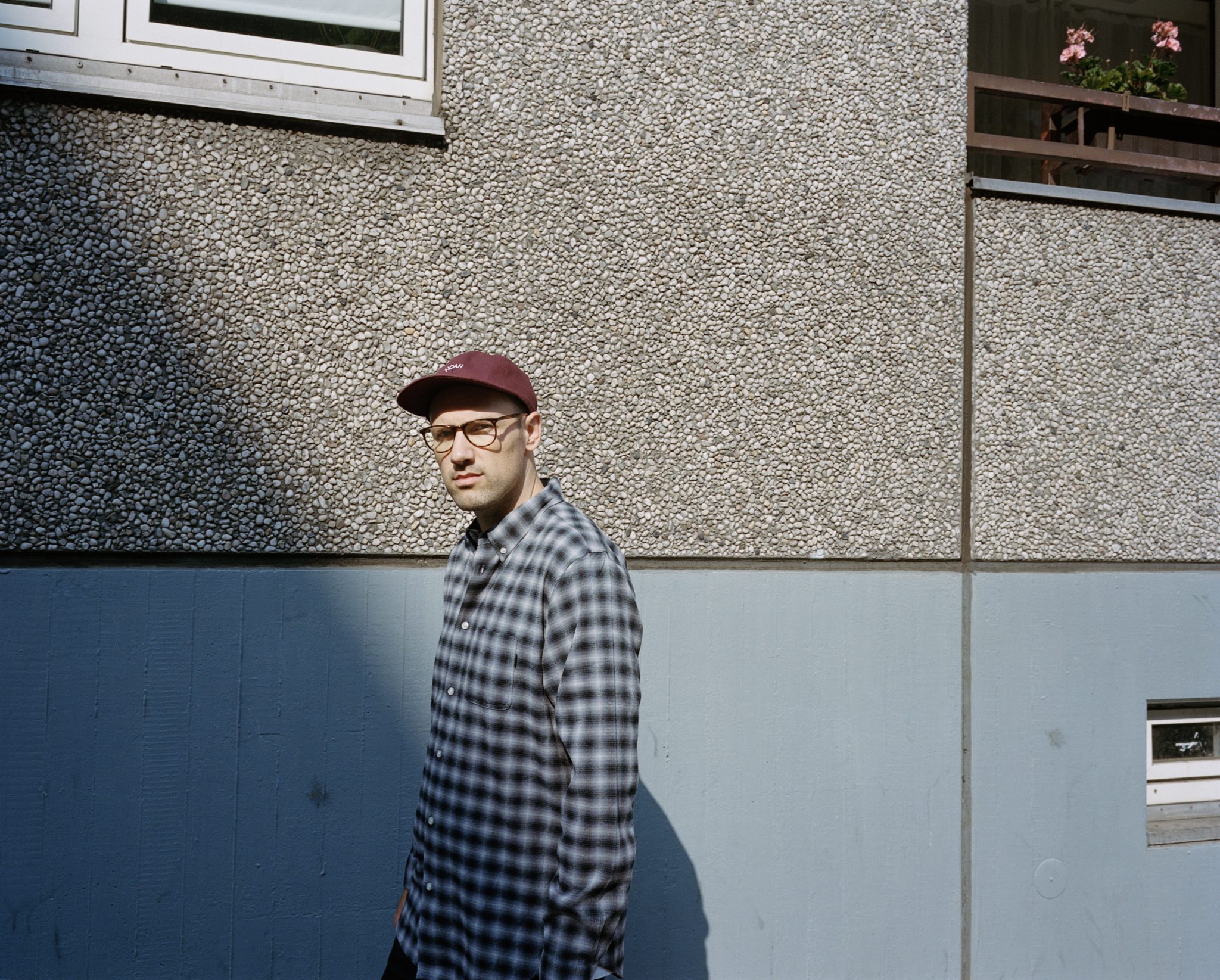
What motivated you to start Highsnobiety?
David Fischer: I was always drawn to the fashion world in some way, but more from a perspective of liking fashion. I liked shopping and looking at things. I was always that kid among his friends who knew the newest things. But at the same time, I always knew I was not going to be a designer. As stupid as it may sound, I wasn’t creative enough for that.
So you were a talented fan.
Maybe. I don’t know if you want to call it that, but it was something that didn’t fit any job description. So I ended up studying business in Switzerland. I kind of stumbled into my final semester and I didn’t really have any courses to attend, so I had a lot of time on my hands to read American blogs – not so much fashion, but gadget and gizmo blogs – and it got me interested in how blogs worked. So I signed up for highsnobiety.blogspot.com and just started writing about stuff I liked. I’m not a trained journalist, and I will never be a fantastic writer, so I used it more like an archive of cool things I came across. Maybe I would put up a cool hotel. Or a cool table. Or maybe a sneaker.
What attracted you to these things?
Certainly a part of me liked that no one else liked it. For years, there was nobody around me – even after starting Highsnobiety – who understood what this was. In Zurich, there were like one or two other guys who understood it, so it was this really small world.
Being a snob I guess can be lonely – writing about Japanese streetwear in Switzerland. What were your days like?
I was super detached. I started working at this corporate design firm and continued doing the blog – at night, at lunch, during the day, during office hours. You have to understand, my parents were like, “What the fuck is he doing?” It really became an obsession to fill these pages. What I was doing with the blog had very little to do with what I’d be doing with my friends. That changed a little over the years, now that everybody knows what Supreme is, and about cool Nikes, and cool this, and cool that.
When you look at what you were doing back then, can you pinpoint why your site took off instead of other blogs? Was it luck?
I don’t know if it was luck – probably partly luck. There’s only one thing I know for sure that contributed to the success of it, and that was consistency. I started the site in March 2005, and then in July 2005 I went to Paris for a week to do my first feature for the website, which was an interview with the Colette team. It was the first thing with original pictures and a bigger story that I did for Highsnobiety. And I remember going on that trip and posting something like, “Oh, I’m in Paris for a week, so it’ll be rather quiet on the page.” That was the first and last time I did that.
No breaks.
In the last 11 years since that happened, there has not been a single day where Highsnobiety did not post news. And half of the time, it was just me. I was very strict with myself. It was seven days a week. I could be at a wedding, or my grandmother’s birthday, and it didn’t matter – I got up at four in the morning to do it, so I didn’t have to do it later that day. And this was new to me, because I was always the kind of guy that was quick and lucky – smart enough to get through school and never really study. This was the first time in my life where I developed an ambition that I didn’t really know in myself. And it never stopped.
“Absorb the Hate”
Highsnobiety’s logo is a black wax seal with a white, crown-shaped emblem in its center. Its name is written on the top left of its homepage in a stately, serifed font. In its office, pairs of brand-new sneakers sit on the shelves, book-ending stacks of colorful design-store volumes. As these details and its name suggest, Highsnobiety looks at itself as a lofty older brother figure within the sector of content-producers servicing the male 18-35 demographic. Yet to the naked eye, the site’s agenda is nearly identical to competitors such as Hypebeast and Complex. Its output consists chiefly of sneaker news and re-posts pertaining to the worlds of hip hop and streetwear. Snobbery, then, is the crucial x-factor. It is the obsessive product-philia that motivated Fischer to spend years updating his compendium of cool things on a daily basis. It is the sense of expertise that reassures consumers in an increasingly chaotic marketplace. Nobody likes a snob, but as the numbers show, many seem inclined to listen.
“Our reader is someone who likes to be informed informally,” says Highsnobiety managing editor Brock Cardiner. As we sit in the same conference room where I spoke with Fischer, he breaks down Highsnobiety’s diet of approximately 45 pieces of content per day. While the load of writing a dozen daily re-posts each is assigned to four staff writers divided between New York and Berlin, the rest of the Highsnobiety editorial team is tasked with developing longer form “original” material. This mix is then overseen by Cardiner, who makes sure there is the right balance of news, lookbooks, and think-pieces – that the site avoids having six Kanye West articles in a row, or an over-abundance of long texts. Social media in this set-up acts both as a bank of source material for articles and as a focus group for what the audience likes. The first is where the newest news comes through browsing and chat-bots. The latter is content’s mate: engagement. Throw in data analysis, and the process becomes an ongoing conversation with an anonymous mass of millions of users. Here, an empirical yet empathic attitude yields positive results. For example, when Highsnobiety added “& Where to Buy Them” to its column “The 10 Best Products to Drop This Week & Where to Buy Them,” the traffic of those posts increased significantly. Engaged users are good at expressing love and hate – and they know how to ask for more.
Tell me about the name Highsnobiety. Why choose something with a negative connotation as the banner for your project?
David Fischer: Well, I interpreted the word “snob” as being obsessed about something in a positive way. Everyone is a snob about something: some about food, some about sneakers, some about something else. So that’s what I always wanted to express with the name. It didn’t have to do with price. For example, I like Rolexes as much as I like a G-Shock. I can get obsessed about either.
It seems like blogging culture invented this type of disposition. You could be a food critic without working for The New York Times. Or a collector without being a billionaire.
It’s true. And it feels like other markets adapted to this, because all of a sudden you have a limited edition couch, or Maserati working on a special edition whatever, or Missoni edition San Pellegrino.
So brands started making more bloggable stuff.
I’m not sure if that’s necessarily a good thing, but everything a brand does today is about asking: “Is it bloggable? Is it shareable? If we launch this on the market, will people share this with their friends on Facebook and Instagram?” If you make an event, there has to be a cool location for people to take selfies. Those things are really happening.
In this sense, the entire luxury market is becoming more like the streetwear market.
I was meeting with a luxury brand recently, and they were talking about not being exclusive anymore – about being inclusive. And I thought that was pretty interesting, because I know they wouldn’t have said that a year ago.
And they would’ve had a heart attack ten years ago.
Exactly. So that was interesting. But it’s a mix of things. They obviously realize that this market has tremendous buying power that they need to tap into. I think the luxury market took a really interesting route, because I was always interested in the luxury market as well as the streetwear market. And I think we were the early ones to mix those two worlds on our site.
I feel like the content on your site creates a kind of flattening. It covers a lot of topics, but everything is treated like a sneaker. You talk about architecture the same way you talk about a graphic tee. You talk about Air Maxes the way you talk about a sports car.
I think that’s part of the DNA. Because we aren’t trying to be architecture pros here, or pretending to be knowledgeable in that world. It’s more us knowing that we have an aesthetic and an opinion on aesthetics that’s valid. And we can apply that to other areas.
Do you think this product fetish lens also made Highsnobiety predisposed to creating sponsored content?
If you look at how our content developed over the years, if you go back maybe five years, the site was basically product plugs all day. This product. That product. This product comes out in two months. This comes out in one month. So that’s our DNA. We’re product- obsessed. So that obviously makes it quite easy to plug sponsored products into it.
You were already plugging things.
That’s what we do. And it’s not sponsored most of the time. That’s what people come to us for, so it wasn’t a conscious decision like, “Hey, what if we got paid to write about this stuff?”
When you switched to doing this sponsored content, did you notice any pushback from your audience?
Yeah, and we still get called out here and there occasionally. But the funny thing is that most of the time, it’s for things that we’re not paid for.
Really?
So that’s where you see that the line is kind of blurry on our end. People might not understand 100 percent what’s paid and what’s not, but I remember that moment where I realized we don’t need to write about everything – this moment where I learned to stand my ground and say, “To be honest with you, we don’t need to write about this, so if you want this feature, you have to pay for it.” That was, for me, a much harder thing to wrap my head around than the switch to getting paid for content.
Learning to withhold love.
Last year, we won a pitch, and the brand invited us to the next pitch, which was very substantial at the time. Then out of this very big deal we pitched, we got nothing. Not one cent. After that, we took a look through our pages and were like, “We featured you 24 times in the past 12 months on our site for free!” Something is wrong here. We actually don’t need to feature you, and we’re not going to get called out by a single one of our readers for not featuring you. It’s a difficult line to overcome when you’re doing something for free, because they ask, “Why should we pay for it now?” That was a difficult time, because the reality is that we’re not pay-to-play. Most of our content is not paid for, and that’s why it pisses me off when people throw that at us. But now the nice thing is that everyone understands that the business model of a modern publishing company is getting paid for your content to a certain degree.

The industry has changed in many ways, but you still see classic journalistic institutions taking a hardline stance against branded content as a way to maintain integrity. Do you see your integrity as something that is compromised? What does “integrity” even mean in this new landscape?
I never thought about that. I’m not even a journalist to start with, so that wall never existed for me. But in many ways, I still feel that certain things are fair toward your audience and others aren’t. You want to be honest with your audience when you communicate with them. Especially today with social media, where you get called out immediately if it doesn’t feel authentic. We’re self-monitored by our market. And those people are a lot harder on you than your boss at The New York Times.
I’ve read your comment sections. People are saying some gnarly shit.
They don’t care what they say, and you can’t even delete those comments, because that’s even worse for the backlash. We take feedback very seriously. Social media is a constant feedback loop, and sometimes you have to rethink something if you’re getting consistent feedback about it. But it’s a fine line. Because if you want to do something new, there will always be pushback. In the end, you have to dictate innovation and absorb the hate.
Tell me about the art – or the craft – of what you do. What makes a good re-post?
The funny thing is, the Internet is re-posting. Tumblr is all about that. They built an entire platform on that. I have to say, in that way, maybe I’m still old school. I still love the hunt for news. I do a good amount of our weekend work, because we don’t have dedicated weekend staff. So I need to know how we service Facebook, each of these platforms, because I’m actually involved on those days. I still love coming across something, knowing that nobody posted this in our world.
So it’s more about sharing something unknown than how you write about it.
That’s it for me. But in the last few years, we have switched gears into producing a ton of well-written, in-depth, longform content that’s published on the site every day. If you come to us Monday to Friday, you will see multiple op-ed pieces, original photo shoots for the website, you’ll see market research pieces on the sneaker market – all these things. And the funny thing is, it really took time for people to realize that all of this was happening on the site. Now, finally, it feels like people notice. I meet people, and they’re like, “Your content has evolved so much over the last few years.”
So you notice that people care.
Yeah, a lot. It makes me feel like the world is still a good place.
The Feed
“It’s a tough task keeping up to date with what’s going on in the world sometimes,” reads the first line of a recent Highsnobiety article entitled “6 Fashion Stories From Around the World You Missed This Week.” It is the throwaway opener to a hastily produced listicle, but also a lucid parable for the ecosystem in which Highsnobiety operates. Since starting the website as a lone snob in Zurich, the niches that Fischer has been in dialogue with have grown into an ornate global slurry. The news has become faster, the product releases more frequent, and the lexicon required to understand all of it more wide. Social media’s gift was to turn this pile into a surging, single-file channel of content where users could “curate” through vast stores of information. This flattening effect of the feed has been both an advantage and a challenge to Highsnobiety and other websites like it. On one hand, its network amplifies their volume. On the other hand, it places all media outlets with substantial overheads on a level playing field with lone wolf super-consumers who garner the same amount of attention. The ones at the biggest disadvantage in this scenario, however, are the companies who urgently and often unsuccessfully seek the relevance of living on the feed. Corporations come across wooden when they speak as users. Furthermore, their organizational structures are specialized in creating products, not content. They can pay to play, but in the end, the choice to follow is left up to the consumer. Having a place in the feed requires an almost emotional level of attachment among strangers. This is the product Highsnobiety sells in its content sponsorships.
“In a literal sense, advertisers look for partners that can distribute their message across the channels the publisher has,” says Jack Drummond, Highsnobiety’s sponsored content editor, “But in another sense, they look for partners to tell their story and to amplify their message through the voice of the publication. They want to leverage our relationship with our audience.” He adds, “The only thing we’re trading on is trust.”
Let’s talk semantics for a second. There is this thing in the world called advertising, and we know what advertising is. And there’s this thing called journalism, and we know what that is as well. But then there’s this thing called “content,” and we see it everywhere, but I’m not exactly sure what it is. You’re in the content business. What is content?
David Fischer: Content is anything that we unleash onto our followers anywhere. That’s how we need to look at it today, right? It can be one picture on Instagram and it can be a picture or video on Facebook. It can be 140 characters on Twitter, or a really longform article on our website. It can be mixed media. Anything that we put out there that reaches somebody that follows us somewhere – that’s content today. And finding the right strategy for each platform, being successful on each platform, that’s what we constantly strive for.
Because you also work as an agency. So when a brand says, “We need more content,” how do you go about creating that? They have campaigns. They have clothes. What are they missing?
Firstly, in order to produce relevant content today, you need to be up to date on each one of these platforms. And those platforms change the way they operate every few months as well. And I think that has become an increasing challenge for big companies – being able to adapt their big structures to Facebook algorithm changes and technical changes that influence performance on these platforms. That’s much easier for an operation like ours than for a bigger operation like them. And then of course also staying on top of aesthetic changes that the audience reacts to – understanding that the audience reacts to certain new looks, to certain visual trends. That’s something that we can see much faster than they can, because we interact with that audience all day.
How can you tell something is doing well? What language does your audience speak to you in?
It’s a blessing and a challenge, because you get all these tools to speak to your audience, but you also need to make sure that you speak to them in the right way. It’s not necessarily a hard thing to reach a big audience. But to reach them in the right way, that’s where the challenge is.
You want engagement.
Exactly. You want that audience to react to what you’re offering them. That’s the big question. Being authentic is the hard part today. Because everybody can drive big metrics through budget or something shocking. But can you actually create something that has an influence on people? Can you create something that leads to these people actually buying into your brand? I think that’s where authenticity is maybe the most important metric of all today. Remaining authentic is hard. For us, it’s hard. Of course, we step into the traffic trap as well. We constantly ask ourselves, “Does this make sense for us as a brand?” Because I think the first step into social media was like: “Great, let’s do this. This is going to drive a shitload of traffic.” And then the next step was like: “Wait a moment, maybe traffic isn’t everything. It needs to be the right traffic.” It’s a tough call sometimes, because you want to grow, but you want to grow in the right way. In these last few years, clickbait has become this really big thing. There’s the Buzzfeeds of the world, Elite Daily, a hundred million clones also. And for a moment, everyone was really impressed by how fast these guys were growing and the insane numbers they were pushing. But I now think we’re entering a phase where it’s like: “Okay, but what does this even mean? Does anybody give a shit what Buzzfeed says?”
When you look at the landscape, what do actual competitors look like for you? What sites are standing on your corner?
It’s funny, because that changed a lot too. For the longest time, Hypebeast was that one competitor of ours – very similar content, similar audience – and we were always inching up over each other. For many years, Hypebeast was much bigger than us, and it’s good to have somebody that’s always a bit ahead. It was a healthy competition. But then I think in the last two or three years, things changed a little bit. They went into e-commerce, we doubled down on our content. So, now, I would not say it’s a competition so much anymore. Today we’re not really competing so much with anyone else in the market. We’re all just competing for a square in somebody’s feed. A few months ago, I asked one of our interns, “Where do you get your sneaker news?” And he answers, “Instagram.” So what the fuck am I supposed to do? Am I competing with Instagram now? The reality is that the kid doesn’t give a shit if he hears about that sneaker release from you or the five other sites that he’s following. That’s when you realize that you need to give them something that they can’t get anywhere else.
Is being faster and dropping something first important for you?
Less. It used to be a lot more important.
How did that change?
Our reader trusts. Our reader counts on us. And we know our reader comes anyway. We have a strong enough name in the market now for people to come for other things that might not depend on being first. You have to imagine that five, six, seven years ago, that was the differentiator. Because the news was the same, more or less. If there’s two, three sneakers coming out today, you better be first.
What’s funny now that our content is all on the feed, is that if you’re late, you’re actually higher up on the feed.
Right … I never thought of that. You’re right.
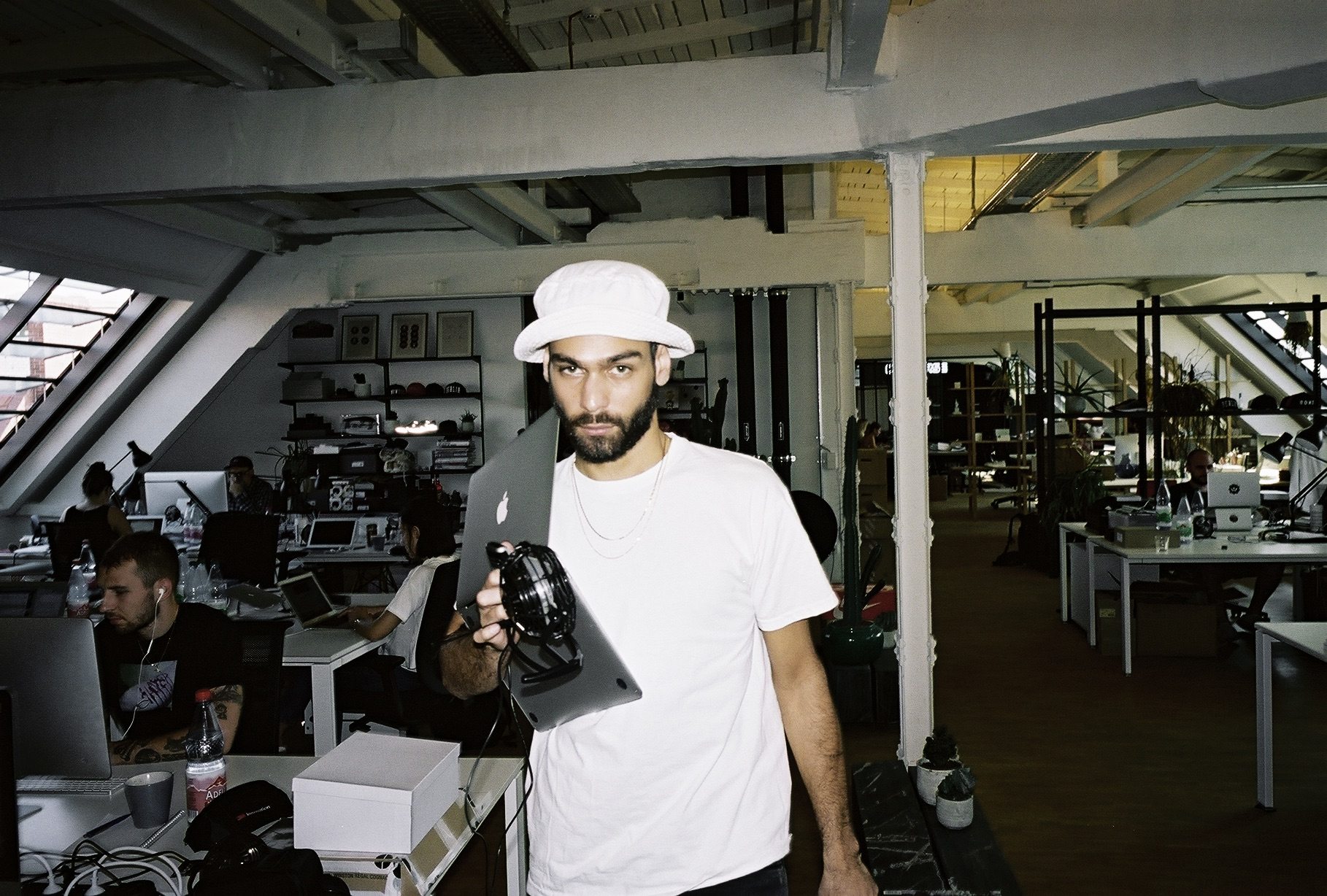
“Everywhere Around Me”
Down the industrial elevator, through the courtyard past the Mykita store, and out into graffitied mountain ranges of public housing in Berlin-Kreuzberg, I leave my meeting with David Fischer thinking about history. Every day for the past 11 years – save for one trip to Paris – Fischer has posted something on Highsnobiety. I wonder what such a history would look like printed on paper. Whether it would read like a story, or appear like a scattered landfill of temporary fixations. Since the societies of ancient Egypt and Mesopotamia, every major civilization has been located near a river. Our river is the feed. Its water is content.
Are there any things that you collect yourself? Do you buy a lot of sneakers?
David Fischer: Yes, I do buy sneakers. I don’t buy a lot compared to a sneaker collector, but I definitely still buy them. The funny thing for me is that obviously we get sent a ton of shit here, but the things I tend to wear are things I actually buy. There’s the rare occasion that I receive something that I like a lot and also wear, but most of the things I wear, I actually bought.
Do you think getting stuff for free makes it less substantial to you?
A little bit, for sure. Also, as stupid as it may sound, I like shopping. I like the experience of shopping. I know exactly what I want when I go shopping. When I go somewhere, it’s like, “Okay, I want a white sneaker, and it needs to look like that.” And if it doesn’t look like that, I don’t buy it.
Have you noticed your appetite and your attractions to things changing over the course of having this blog? You must see and ingest so much.
I definitely am influenced by trends also. I might not like everything for myself, but I like things even if it’s on others. In the early years, we sometimes worried, “So what do we do if sneakers are not in fashion?” Then the financial crisis came around in 2008, and people were actually less into sneakers. Suddenly everyone was wearing boat shoes and Red Wings. So we wrote about that.
Are there trends you’ve seen that have surprised you?
The boat shoe thing was definitely a surprise. What scares me a little bit right now, is how quickly things become very big. And how quickly they die again, too. Like Vetements, for me, was incredible. Because what does that mean? Maybe from a business standpoint, that’s actually when it gets good. We’re already over it, which might mean that a general market is just starting to buy into it.
And this speed is something new?
Yes. I’m not sure I should even say this, but so many brands now make it all by themselves. Because of social media, they can be their own voice and they can have their own following. If you’re a young t-shirt brand with 100,000 followers on Instagram, you can probably sell out of your shit without anybody posting about it. So you don’t need press for sales. I remember in the early years when we started, nobody wanted to be on the site. It wasn’t cool for Alife or Supreme to be on a blog.
So you were actually chasing the brands?
Absolutely. Then the financial crisis hit and everyone was like, “Fuck, we need that traffic.” But now we’re in a phase again where a lot of young brands don’t actually need traffic. Maybe they need it to be perceived as a “real” brand. For me, I think that’s the single biggest question: Can you still build a legacy today? Can you still build a Supreme today? Can you still build a Gucci today? And how? It’s all so fast. And you need to be able to afford to not make money in the beginning. Who can afford to take that kind of time?
Well, it seems like time itself has changed. If five million things happen in a year, then a year now feels like a decade.
It’s insane. For example, we have these posts every week where we put together all the interesting sneaker releases of the weekend. I think one of the recent ones had like 25 sneakers. I remember there was a time when one dope sneaker was released on the weekend. And if you got it, lucky you.
The market has gotten bigger. There’s more people following this now than when you were doing this by yourself in Zurich. Does that make things feel different for you?
I certainly do think that there are a lot more people out there that fully understand what we do than ever before. This whole notion of limited products is nothing rare anymore. Everybody does it. The supermarket has limited edition chips. To be frank, I sometimes miss how it felt in the first few years – like we were a secret club. Out of a million people, you would spot that one guy wearing a specific shoe and you knew he knows Highsnobiety. Somebody wearing Supreme in 2004, 2006 – that was a special club. I don’t want to make more of it than it actually is, but you knew there was a level of understanding and you knew that most others weren’t getting it. That’s definitely changed. It’s now everywhere around me.
Since you still do these weekend dives for content, are there things you’ve seen recently that have gotten you excited like that again?
I’m not sure I can come up with something right now, but the one thing I can say is that I’m often excited by stuff we wrote about ten years ago. And in some cases, it’s things I couldn’t afford ten years ago that we wrote about that I can afford today. It’s almost nostalgic at this point for me. It’s kind of like, now I want it because I couldn’t have it back then.

Credits
- Interview: Thom Bettridge



